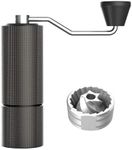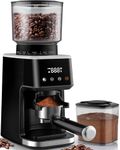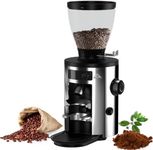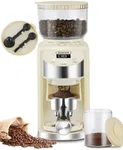Buying Guide for the Best The Espresso Coffee Grinder
Choosing the right espresso coffee grinder is crucial for achieving the perfect cup of espresso. The grinder you select will significantly impact the flavor, aroma, and overall quality of your coffee. When selecting an espresso coffee grinder, consider the following key specifications to ensure you find the best fit for your needs.Grind Size SettingsGrind size settings refer to the range of coarseness or fineness that the grinder can produce. This is important because different brewing methods require different grind sizes. For espresso, a fine grind is essential. Grinders with a wide range of settings allow for more precise control over the grind size. If you primarily make espresso, look for a grinder with fine-tuning capabilities to achieve the perfect grind for your machine. If you also enjoy other brewing methods, a grinder with a broader range of settings will be more versatile.
Burr TypeThe burr type refers to the mechanism that grinds the coffee beans. There are two main types: flat burrs and conical burrs. Flat burrs tend to produce a more consistent grind size, which is crucial for espresso. Conical burrs are often quieter and can handle a wider range of grind sizes. If you are focused on achieving the best espresso, flat burrs might be the better choice. However, if you value versatility and quieter operation, conical burrs could be more suitable.
Grind ConsistencyGrind consistency refers to how uniform the coffee particles are after grinding. Consistency is vital for espresso because it ensures even extraction, leading to better flavor and aroma. High-quality grinders produce more consistent grinds. To determine the right grinder for you, consider how important consistency is for your espresso experience. If you are a coffee enthusiast seeking the best possible espresso, prioritize a grinder known for its consistency.
Grind SpeedGrind speed is the rate at which the grinder processes coffee beans. Faster grinders can save time, but they may generate more heat, which can affect the flavor of the coffee. Slower grinders tend to preserve the beans' integrity better. If you are often in a hurry, a faster grinder might be more convenient. However, if you prioritize flavor and quality, a slower grinder that minimizes heat buildup could be the better option.
Dosing OptionsDosing options refer to how the grinder dispenses the ground coffee. Some grinders have a doser that collects and dispenses a set amount of coffee, while others are doserless and grind directly into the portafilter. Doser grinders can be convenient for making multiple shots quickly, but they may leave some coffee grounds behind. Doserless grinders offer more control and freshness, as the coffee is ground directly into the portafilter. If you make multiple espressos in a row, a doser might be useful. For single shots and maximum freshness, a doserless grinder is preferable.
Build Quality and DurabilityBuild quality and durability refer to the materials and construction of the grinder. High-quality materials and solid construction ensure the grinder will last longer and perform better over time. Stainless steel and heavy-duty plastics are common in durable grinders. If you plan to use your grinder frequently, investing in a well-built, durable model will save you money and hassle in the long run. Consider how often you will use the grinder and choose one that can withstand regular use.
Ease of CleaningEase of cleaning refers to how simple it is to maintain the grinder. Regular cleaning is essential to keep the grinder functioning well and to ensure the best-tasting coffee. Some grinders have removable parts that make cleaning easier, while others may require more effort. If you prefer low-maintenance appliances, look for a grinder with easy-to-clean features. Consider how much time you are willing to spend on maintenance when choosing your grinder.





















